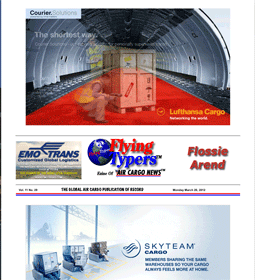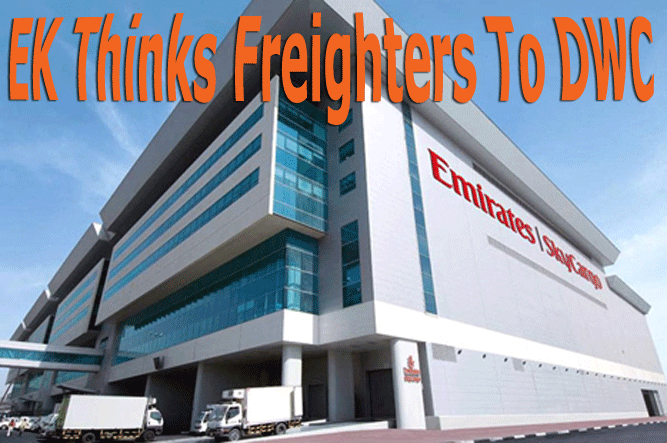
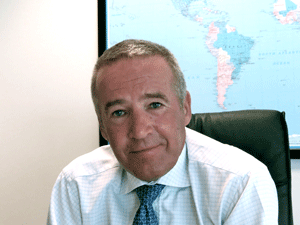 Ground
terminal leader at Emirates SkyCargo, Dave Gould is the ultimate
operations executive. Ground
terminal leader at Emirates SkyCargo, Dave Gould is the ultimate
operations executive.
For years now he has been on a never-ending
adventure as the most important (if not most visible) Emirates
SkyCargo individual to be mentioned in the same sentence as ‘cargo
terminal,’ or, in the parlance of today’s operations,
‘Air Cargo Mega Terminal.’
A life-long air cargo operations
man, Gould started his career at the fabled British Caledonian
(as did Emirates President Tim Clark, and a handful of others
still working at the Dubai-based carrier). Today he oversees an
absolutely critical part of Emirates SkyCargo from his offices
located on the fourth floor of the big, DXB Cargo Mega Terminal
handling facility.
From this launching pad he roams
about the facility, keeping a well-weathered eye out for anything
that might slow down the process in a place that always seems
to be operating in over-drive.
Actually, the Cargo Mega Terminal
was designed to handle 1.2 million tons annually and is currently
handling more than that, so Emirates still finds use for its original
air cargo facility, located right next door where overspill of
various flights and commodities are handled.
But barely four years into Cargo
Mega Terminal Dubai operations, there comes word of another major
move with big changes in the wind, and Dave Gould once again must
call upon his considerable expertise and inventiveness.
If he is worried, he sure doesn’t
show it, as he outlines what lies ahead for Emirates SkyCargo
operations Dubai.
“The Cargo Mega Terminal is
doing rather well,” Dave assures us.
“As we celebrate our fourth
year here I think it is safe to say that we have handled the step
change from self-handling to automation, migrating quite well
and with some speed into a procedural upgrade that was so alien
to how we had operated previously.
“But people took to it very
quickly; actually in most cases, much faster than we expected.
“We’ve got a very mature
operation now—our service dependability levels are up in
the almost perfect 99-plus percent range.
“But believe it or not, that
is not really the story here right now,” Dave Gould says.
“Because of the capacity challenges
at Dubai International Airport, we are considering and looking
at moving our freighter operations to the new Dubai World Central
Airport (DWC). To this extent we are now engaged in looking at
building new facilities and moving our freighter fleet to DWC.
“So for today, and actually
for some months now, I have been quite busy working with consultants
on the design for a great new Emirates SkyCargo facility at DWC.
“We are now embarked upon
a very aggressive time-line to design, build and bring into operation
a brand new facility.”
Dave Gould faces a massive challenge.
He describes splitting the Emirates
SkyCargo operation from a combination of freighters and belly
lift, which, to date, have operated alongside one another at DXB,
into a freighters-only operation at DWC and belly-only at DXB.
The logistical challenge is no small
potatoes; it must be done correctly for one of the fastest growing
air cargo operations on the planet to continue operating at top
efficiency.
But come to think of it, Dave Gould
has been down this road before: first operating the original Emirates
SkyCargo Terminal hub, with its thousand workforce, and then moving
into the Cargo Mega Terminal with its complex automation.
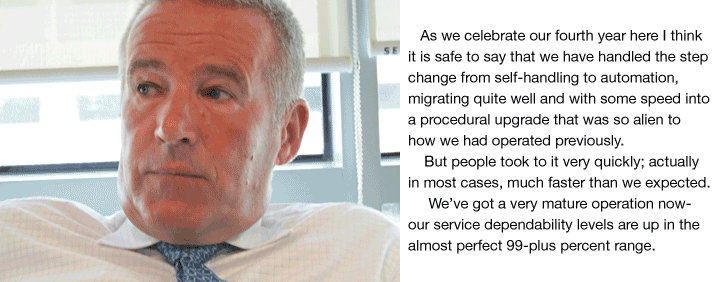 |
Now, once again, as if
to prove all of these advances were not a dream, there is demand
to not only build an even bigger air cargo facility some 60 kilometers
down the road, but also coordinate all the freighters, belly lift,
trucks, security, and everything else, and get it all in ship
shape within a very short period.
As he speaks, we wonder when workmen
will bring in a convertible couch for sleeping; we can only imagine
that as it gets closer to the deadline, Dave may be forced to
camp out at the airport.
“We will have to get it right
as there are significant transfers of load between our two fleets,
both all-cargo and belly lift.
“We are working closely with
the folks from RTA (Dubai’s Roads and Transport Authority)
to develop connections between the two airports and are getting
positive feedback so far from that sector.
“The moving of air cargo to
and from DWC will put many trucks on the road and will require
a well-articulated plan of feeding traffic basically into Dubai,
which is a downtown airport unlike most other airports of the
world.
“We are also working with
the collateral challenges of cargo security that of course is
a top priority with Emirates SkyCargo.
“Security as a must is also
quite intrusive to operations, which in our case will demand rapid
connection times with cargo that we have to screen and truck from
here to there and unload and reload and vice–versa.
“At DWC, our first building
phase will see creation of a facility that can handle 750,000
tons per year.
“We have a tentative second
phase that will add an additional 300,000 square feet.”
 |
We wonder what lessons
were learned building Dubai Cargo Mega Terminal that might be
applied to the new mammoth project now underway at DWC.
“The biggest lesson that we
learned here at CMT (without meaning to offend anyone) that may
be of some benefit at DWC is that we at Emirates SkyCargo need
to be involved in every step of the design plan because, for the
high demand business we are in, getting things right is absolutely
essential.
“At the new airport we have
been given a massive plot of land with plenty of room to grow.
“But looking ahead, while
the challenge is great, it is not so much the building and the
physical construction that looms large, but rather hitting the
time lines as described whilst maintaining our service levels:
that remains under close scrutiny as our number one priority right
now.
“There is about a 60-kilometer
distance between the two airports and, with all the other factors
that will come to the fore as described earlier, ferrying the
loads is our biggest challenge and concern right now.
“As before when this place
was built, I am certain we will get it right.”
Dave Gould placed head and heart
in the Dubai adventure after some 18 years in the UK with British
Caledonian Airways and then British Airways Cargo.
Dave moved out to Dubai at the end
of 1992 and took the position of GM Cargo Terminal Operations,
dnata.
During his time with dnata Cargo,
he played a leading role in the introduction of an Inter-airport
road feeder network within the UAE and introduced the Freezone
Logistics Center, aimed at low cost charter operators.
Since 2007, Dave has been Senior
Vice President Global Operations Worldwide with Emirates SkyCargo
and has overseen the move to self-handling and other advanced,
21st century cargo handling procedures now considered business
as usual at the ultramodern Cargo Mega Terminal.
Looking ahead, thoughts immediately
drift back to talk of a bonded highway between the two facilities,
which was considered a must in the original plan, but now some
years later, with the growth of population and other road connections
between DXB and DWC, cannot be built.
Undaunted, Dave has his eyes on
the prize and in between deep breaths offers this:
“Hope springs eternal and
as mentioned we are talking to RTA so that maybe some areas of
road can be dedicated to us.”
There is a strip of road here called
the Outer Bypass Road that goes around Dubai, which is slated
for use by Emirates SkyCargo.
“We plan to use that highway,
although connecting that road back to the airport will require
a spur.”
It is interesting that, at this
point in time during a migration toward belly lift, with kero
prices spiking ever upward, Emirates SkyCargo is splitting up
its services with additional expense.
Dave breezes by that one, confirming,
“It is indeed expensive to operate freighters… unless
you happen to have the B777s as we do.
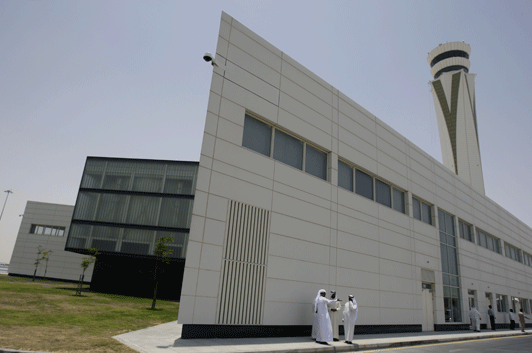 “So
we continue to plan for the day as, for example, our Hong Kong
freighter drops in here with 100 tons of air cargo that is redistributed
amongst a score of passenger flights. “So
we continue to plan for the day as, for example, our Hong Kong
freighter drops in here with 100 tons of air cargo that is redistributed
amongst a score of passenger flights.
“In our tomorrow that freighter
flight will land at DWC (pictured right) and our plan will be
to bring that cargo to the DXB ramp into outbound aircraft without
a hitch.”
“Initially we will utilize
less automation as freighter traffic is quite built up anyway,
and I have always believed that air cargo should not be complicated,
but rather utilized in straight lines.
“Also, although this may sound
a bit cliché and in the moment, we shall be making our
cargo as paper-free as possible to speed us along as we move between
gateways.
“Overall, the mission is to
keep things direct and as simple as possible.
“The idea is to line up every
process: the security, police, customs, our people, their people,
everyone, to make the movement of air cargo as seamless as possible.
“Security does not ever go
away, but we can make it a more integral part of the system so
that when there is a call out, the entire process does not stop,
but rather accounts for the incident whilst continuing to flow.
“I guess the upshot of all
of this is that we will once again pioneer a great advancement
in air cargo that, once on display in Dubai, will become the norm
elsewhere.
“Right now, it is pedal to
the metal around here.
“The way this Cargo Mega Terminal
operates almost without a hiccup gives us that opportunity to
reach even higher,” Dave Gould says, reaching for his rolled-up
plans as another thought occurs, and we take our leave.
Geoffrey/Flossie
|


 “So
we continue to plan for the day as, for example, our Hong Kong
freighter drops in here with 100 tons of air cargo that is redistributed
amongst a score of passenger flights.
“So
we continue to plan for the day as, for example, our Hong Kong
freighter drops in here with 100 tons of air cargo that is redistributed
amongst a score of passenger flights.





 Ground
terminal leader at Emirates SkyCargo, Dave Gould is the ultimate
operations executive.
Ground
terminal leader at Emirates SkyCargo, Dave Gould is the ultimate
operations executive.